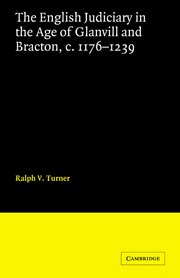Book contents
- Frontmatter
- Contents
- Acknowledgements
- Abbreviations
- 1 THE REPUTATION OF THE ROYAL JUSTICES
- 2 GLANVILL AND HIS COLLEAGUES, c. 1176–89
- 3 THE ORIGINS OF A PROFESSIONAL JUDICIARY IN THE REIGN OF RICHARD I
- 4 KING JOHN'S CORPS OF JUSTICES
- 5 PATTISHALL, RALEIGH AND THEIR COLLEAGUES
- 6 THE WORK OF THE JUSTICES
- Conclusion: The judges and their critics
- Appendix: Royal justices, c. 1176–1239
- Manuscript sources
- Index
- CAMBRIDGE STUDIES IN ENGLISH LEGAL HISTORY
2 - GLANVILL AND HIS COLLEAGUES, c. 1176–89
Published online by Cambridge University Press: 07 October 2011
- Frontmatter
- Contents
- Acknowledgements
- Abbreviations
- 1 THE REPUTATION OF THE ROYAL JUSTICES
- 2 GLANVILL AND HIS COLLEAGUES, c. 1176–89
- 3 THE ORIGINS OF A PROFESSIONAL JUDICIARY IN THE REIGN OF RICHARD I
- 4 KING JOHN'S CORPS OF JUSTICES
- 5 PATTISHALL, RALEIGH AND THEIR COLLEAGUES
- 6 THE WORK OF THE JUSTICES
- Conclusion: The judges and their critics
- Appendix: Royal justices, c. 1176–1239
- Manuscript sources
- Index
- CAMBRIDGE STUDIES IN ENGLISH LEGAL HISTORY
Summary
ELABORATION OF THE EYRE SYSTEM
The late twelfth and early thirteenth centuries were a time of great growth for more rational procedures, centralization, and professionalization in government. Nowhere in Europe can this process be seen more clearly than in England under Henry II, who created new machinery of justice for his subjects. He made the new procedures available in his own court, the curia regis, operated by his own servants. Henry's innovation set in motion a growing centralization, as more and more cases came into the curia regis instead of into the traditional courts. Some means of carrying royal justice to the people was needed, and in the late twelfth century Henry II revived the practice of his grandfather in sending itinerant commissioners to the counties. As Lady Stenton said, ‘In the last ten years of Henry II's reign there was a rapid coming and going of itinerant justices to hear an ever increasing volume of pleas.’ Yet the eyre system took shape slowly. In the first eleven years of Henry's reign, there had been only ‘occasional desultory visitations of curiales;’ but then began the series of assizes, which by expanding the scope of royal justice made necessary new circuits of itinerant justices.
The great council at Clarendon in February 1166 resulted in the Assize of Clarendon, which created the jury of presentment, bringing more accused criminals to trial.
- Type
- Chapter
- Information
- Publisher: Cambridge University PressPrint publication year: 1985
- 1
- Cited by



